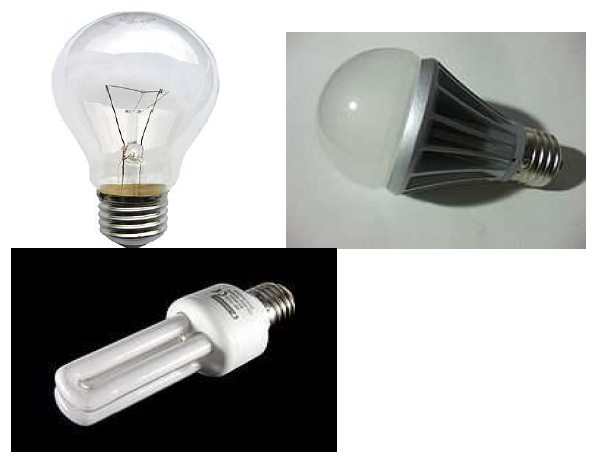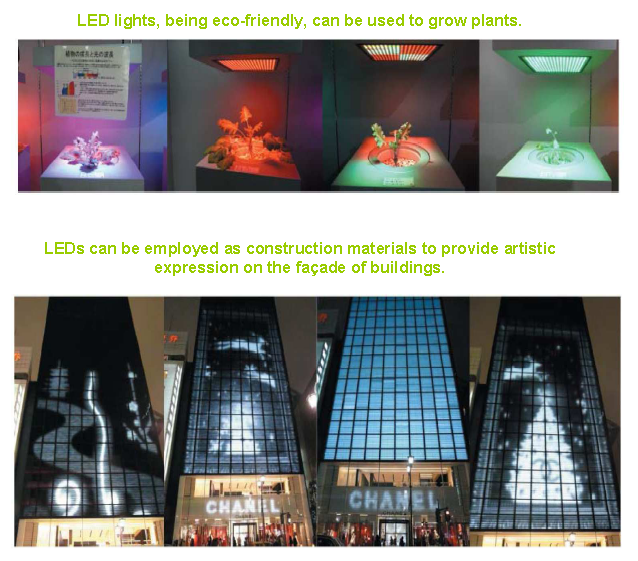by Sanchez, Richmond Mozo

Measures have been passed by several governments around the world to phase out incandescent light bulbs for general use. The aim is to expand usage and spur technological development of more energy-efficient lighting alternatives, such as compact fluorescent lamps (CFLs) and light emitting diode (LED) lamps. Brazil and Venezuela began to phase them out in 2005, and the European Union, Switzerland, and Australia started to do the same in 2009. Similarly, other nations are planning scheduled phase-outs: Argentina, Russia, and Canada in 2012, and the United States and Malaysia in 2014.
The worldwide legislation has met some public criticism due to the additional costs imposed on consumers by government ruling, as well as the light quality of the incandescent lamps not being matched by the alternative technologies. The mercury pollution potential of some alternatives to incandescent light bulbs have also stirred environmental concerns, notably that of the CFLs.
The Energy Independence and Security Act of 2007, enacted by the US Federal Government in December 2007, demands all general-purpose light bulbs that produce 310–2600 lumens of light to be 30% more energy efficient (similar to current halogen lamps) than then-current incandescent bulbs by 2012 to 2014.The new efficiency requirement will begin with 100-watt bulbs in January 2012 and end with 40-watt bulbs in January 2014.
The results of the 4th Annual SYLVANIA Socket Survey in the U.S., released on November 15, 2011, show that for the first time since the study started in 2008, a majority of Americans (55%) indicated awareness of the 2007 federal ruling that will phase out most standard incandescent light bulbs. This pioneering survey revealed efforts to raise consumer consciousness of the phase-out are working, with awareness growing by 19% in the last year and 29% since 2009. However,almost half of Americans are still unaware of the major changes stirring the lighting industry.
The SYLVANIA Socket Survey is commissioned yearly by North America‘s largest lighting company, OSRAM SYLVANIA, a division of Siemens AG. It is the lighting industry‘s only gauge of the evolving consumer preferences on the national level. In this year‘s survey, it is noteworthy that the value consumers put on their lighting products being made in America was an added dimensionrevealing that 73% of Americans consider it important that their bulbs are “Made in America”.
The survey found that the most important purchase factors include: brightness, long life, price and energy – all important to more than 80%. Less important, but still considerations for the majority are: color quality, “American-made” and dimming effects.
As in 2010, the majority have used alternative bulbs for increased energy efficiency this year, but more switched for this reason in 2009. More have used incandescent bulbs this year (87%) than in the past, while CFL usage remains steady at about 70%, for second place. Halogen lamps come in third, with 42% usage. Total LED stand-alone usage is low, with 13% reporting having them at home, but usage has increased directionally from 2010 and 2009. Total reported LED ownership is now at 29%. Awareness of bulb options has remained stable over the past few years. Halogen lamps remain the most widely recognized (91%), followed by LED bulbs (80%) and CFLs (68%).
The biggest concerns with CFLs include price, amount of light, and mercury content – involving at least 25% of consumers. These concerns have remained steady over time.
Consumers will most likely switch to new alternative bulbs once traditional bulbs are phased out. Half of them plan to do this, although more may switch to lower wattage incandescent bulbs than in the past. The majority expressed excitement about the phase out, but a considerable minority – at least one-third – are worried. For a consecutive third year from 2009, 13% of respondents revealed that they plan to save up or “hoard” 100-watt incandescent bulbs.
With the phase-out of 100-watt incandescent bulbs soon, consumers now have CFLs and halogen lamps as options. While CFLs use less energy and last longer, halogen lamps create light that approximates more that from incandescent bulbs.
At present, LED lamps that emit as much light as a 100-watt bulb are not yet available, although many companies reportedly plan to sell them next year. LEDs with the equivalent of a 40-, 60- or 75-watt standard bulb are now available, although their price can be as high as $40.
CFLs, like all fluorescent lamps, contain a little mercury as vapor inside the glass tubing, about 4.0 mg per bulb. A broken CFL will release about 4% of its mercury content and can introduce the mercury directly into a populated indoor area.
Although more expensive than incandescent light bulbs, the extra cost on CFLs is repaid in the long-term, as they consume less energy and have longer operating lives.
Some CFLs may not work with existing dimming circuits, but more dimmable ones are expected to become available soon. Mains voltage halogen bulbs are a more efficient dimmable option to ordinary incandescent bulbs and are readily available. However, because they are designed to be operated at a specific temperature, halogen bulbs are not entirely compatible with dimming.
Several companies produce dimmable LED lamps, although not all LED lamps work well with dimmers.
An incandescent lamp creates light with a black body spectral distribution while its alternatives don’t possess the same spectral characteristics. The latter employ phosphors to produce light with significantly irregular spectral distributions, resulting in color casts in photography and failures of color matching when compared to incandescent produced light or daylight. However, this may not really be a disadvantage for domestic lighting. Further, new phosphor formulations have improved the perceived color of the light emitted by CFLs, with the best "soft white" CFLs as close in color to standard incandescent lamps.
As of 2010, CFLs have been joined by two alternative technologies – LED lamps and electron stimulated luminescence (ESL) lamps. Both LED and ESL technologies are mercury-free, not requiring special disposal or handling, and have long lives as compared to incandescent bulbs.
ESL technology is about 70 percent more energy efficient than incandescent lamps, and are rated to last up to five times longer. ESL lamps emit light by stimulating a phosphor, a technology used in cathode ray tubes, and create light with similar quality.
LED lamps are used for both general and special purposes. For color lighting, LEDs produce many colors, which are emitted with requiring filters. The colors are also more robust than those of incandescent bulbs. Their energy efficiency is thus improved compared to a white light source that generates all colors of light and then discards some of the visible energy through a filter.
Compared to fluorescent bulbs, LED light bulbs have the advantage of not containing mercury, of turning on instantly, and their lifetime is unaffected by cyclical on and off, so that they are well suited for light fixtures where bulbs are often turned on and off. LED light bulbs also tend to break less.
To promote efficient lighting globally, the United Nations Environment Program, as supported by the GEF Earth Fund, Philips Lighting and OSRAM GmbH, has established the “en.lighten” initiative. This aims to accelerate global commercialization and marketing of efficient lighting technologies by providing support to various countries. It thus seeks to promoting high performance technologies, eliminating inefficient lighting technologies, and substituting traditional fuel-based lighting with modern, environmentally sound alternatives.
In line with these global efforts, it is noteworthy that OSRAM SYLVANIA has developed the only American-made 72-watt halogen bulb designed to replace the 100-watt standard incandescent bulb soon to be phased out. Now commercially available, the mercury-free SYLVANIA halogen bulbs consume 28% less energy, are fully dimmable, and have a color rendering index of 100.
Additionally, the company has highlighted an award-winning LED bulb to replace a 100-watt incandescent type. The 18-watt SYLVANIA ULTRA LED A-line bulb, which is predicted to be available in the Spring of 2012, provides 82% energy savings over standard incandescent technology and lasts 25 times longer.
In summary and focusing on LEDs, the latter currently rank second to halogen light bulbs in terms of consumer awareness of their availability for use, but rank lowest in terms of actual usage by Americans. Like CFLs, the main issues with LEDs are relatively high price and low amount of light produced. Their overwhelming advantages, however, are they do not use phosphors to produce light, do not contain mercury, turn on instantly, with very long lifetimes not affected by cyclical on and off, less apt to break, come in multiple, robust colors which are emitted without using filters, and of course, with dimming effects and extremely high energy savings. Overall, LEDs are the most eco-friendly lighting alternative to incandescent light bulbs and can produce the most aesthetically pleasing lighting effects.
As with any promising novel technology, more intensive and extensive research efforts should be channeled into making the LED system, composed of the LED main component, combined with optical, thermal and electronic solutions, produce more light in a more economical (cheaper) way. Simultaneously, its many advantages should be honed and fine-tuned for a wide range of commercial and scientific applications. Americans and the rest of the world should be continuously made aware of the vital role LEDs play in green energy technology development, as well as in artistic display domains.














